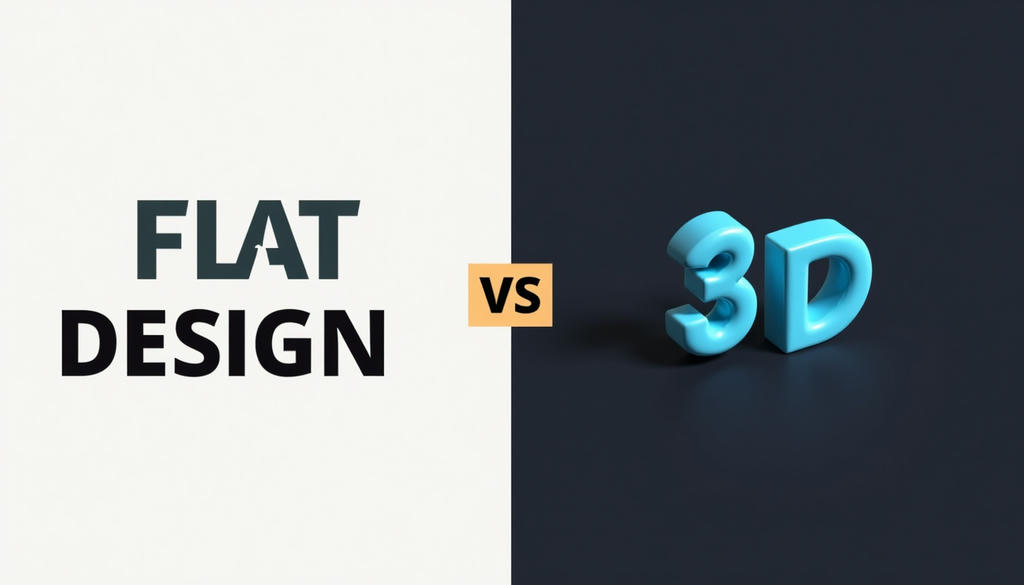Design trends evolve quickly, and in the digital age, the tug-of-war between flat design and 3D design has become one of the most fascinating debates. Flat design—clean, minimal, and focused on simplicity—rose to fame with the rise of mobile apps and responsive web layouts. Meanwhile, 3D design has been making a comeback, especially with advancements in rendering technology, AR/VR, and immersive digital experiences.
Whether you’re designing websites, apps, or experimenting with a free logo design tool, understanding the strengths of both approaches can help you decide which style works best for your project. Each comes with its own set of benefits, challenges, and trends worth keeping an eye on.
The exciting part? Flat and 3D aren’t always in competition. Many modern designers are blending them in creative ways, pushing visual communication into a new era.
A Quick Look: Flat Design vs. 3D Design
Flat Design
Flat design emphasizes simplicity, usability, and minimalism. It avoids complex textures, gradients, and shadows, focusing instead on bold colors, clean lines, and easy-to-read typography.
- Pros: Fast-loading, mobile-friendly, timeless aesthetic.
- Cons: Can sometimes feel too plain or generic if not executed well.
3D Design
3D design adds depth, realism, and interactivity. With tools like Blender, Cinema 4D, and advanced rendering engines, designers can create hyper-realistic graphics, lifelike animations, and immersive environments.
- Pros: Eye-catching, immersive, conveys innovation.
- Cons: Can be resource-heavy, time-consuming, and less versatile for simple interfaces.
Why Flat Design Remains Popular
1) Mobile-First Usability
Flat design shines in mobile-first environments. Its clean layout translates beautifully to smaller screens, ensuring readability and quick load times. In fact, research shows that 88% of users won’t return to a site after a poor experience, making simplicity critical.
Actionable tip: When designing apps or websites, stick with flat design for core UI elements like buttons, menus, and forms to maximize usability.
2) Faster Performance
Flat graphics are lightweight, reducing file size and improving site performance. Google emphasizes page speed as a ranking factor, which means flat design indirectly supports SEO.
Actionable tip: Use SVGs for icons and graphics—they’re scalable, crisp, and don’t slow down your site.
3) Timeless Branding
Minimalism never really goes out of style. Flat logos, icons, and layouts feel modern and universal, making them a safe choice for businesses that want longevity.
Why 3D Design Is Rising
1) Immersive Experiences
As AR/VR technologies grow, 3D elements are becoming more valuable for creating immersive interactions. From product previews to interactive learning tools, 3D design offers experiences flat graphics can’t replicate.
Example: Ikea’s app lets users place 3D models of furniture in their rooms before buying—a perfect blend of practicality and visual innovation.
2) Social Media and Marketing
Brands are leaning into 3D motion graphics to stand out in crowded feeds. A static flat graphic may be overlooked, but a dynamic 3D animation grabs attention and boosts engagement.
Actionable tip: Incorporate lightweight 3D animations or looping videos in your marketing campaigns to increase click-through rates.
3) Advances in Tools
Tools like Adobe Dimension, Blender, and Figma’s plugins are making 3D design more accessible. This democratization means even small businesses and freelancers can experiment with 3D elements affordably.
Hybrid Approaches: Flat Meets 3D
The most exciting trend isn’t flat or 3D—it’s how the two are being blended. Designers are experimenting with “semi-flat” designs that keep the minimalism of flat graphics but introduce subtle shadows, gradients, or 3D-style depth.
- Neumorphism: A style that mimics soft 3D elements while staying minimalist. It creates depth with shadows and highlights but keeps interfaces clean.
- Illustrations with Depth: Many modern websites use flat illustrations but add layered elements or perspective, bridging the gap between flat and 3D.
- 3D Icons: Instead of full 3D models, designers are using lightweight 3D-styled icons to add personality while keeping performance in check.
Actionable tip: Try mixing flat backgrounds with 3D accent elements to create balance—this works well for hero sections on websites or app splash screens.
Industry-Specific Trends
- E-commerce: Flat design dominates for speed and clarity, but product previews increasingly lean on 3D.
- Gaming & Entertainment: 3D is king for immersive experiences, though flat icons and menus still anchor navigation.
- Corporate Branding: Flat design still rules logos and professional identities for its simplicity, but brands targeting younger audiences often add playful 3D visuals.
- Education & Training: Interactive 3D visuals help learners engage with content, though dashboards and interfaces stick to flat for clarity.
How to Choose Between Flat and 3D
Ask yourself:
- What’s the goal? If usability and speed matter most (like for a banking app), flat wins. If engagement and immersion are priorities (like in gaming or marketing), 3D shines.
- Who’s the audience? Younger audiences tend to respond better to 3D’s vibrancy, while professional or corporate users often prefer flat simplicity.
- What are your resources? 3D design may require more time, skill, and computing power. Flat design is faster and more budget-friendly.
The Future of Design: Convergence
Looking ahead, we’re not likely to see one style dominate completely. Instead, expect to see more hybrid solutions—designs that leverage the strengths of both approaches. As technology improves, designers will continue experimenting with balance: flat for functionality, 3D for storytelling and engagement.
Final Thoughts
Flat vs. 3D design isn’t an either/or choice anymore. Both have their place, and the smartest designers know how to leverage each where it makes the most impact. Flat offers timeless simplicity, speed, and usability. 3D brings immersion, personality, and engagement. The real magic lies in blending them thoughtfully to create experiences that feel modern, memorable, and user-focused.
In short: design for your audience, not just the trend. When flat and 3D are used strategically, your visuals can do more than look good—they can tell a story, capture attention, and drive real results.


